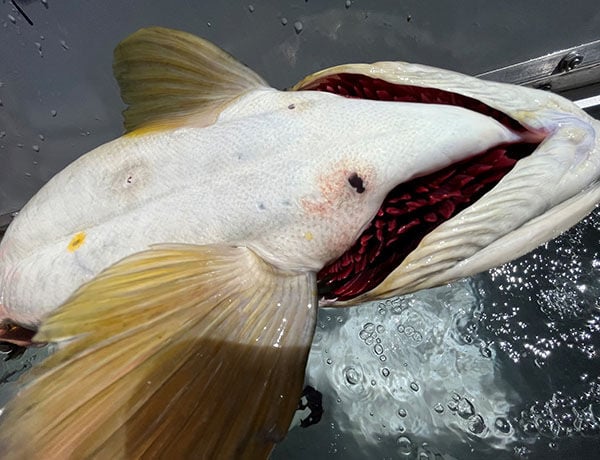https://www.heraldandnews.com/news/lamprey-found-in-miller-lake-the-first-findings-since-the-1950s/article_b82807c8-69dd-11ed-8113-d3600a41f71e.html
 <
a
fresh Miller Lake lamprey wound is found on a brown trout caught
by Jordan Ortega. Photo by Jordan Ortega <
a
fresh Miller Lake lamprey wound is found on a brown trout caught
by Jordan Ortega. Photo by Jordan Ortega
Lamprey
found in Miller Lake — the first findings since the 1950s
Lamprey, an ancient lineage of jawless fish, have been found
in northern Klamath County’s Miller Lake for the first time
since the 1950s.
Studies by the Oregon Department of Fish and Wildlife said
wounds caused by lampreys were found on six brown trout
caught by Jordan Ortega at Miller Lake this past summer.
Ortega, an Oregon State University graduate student, is part
of a team working to return lamprey back to Miller Lake.
The Miller Lake lamprey, which weigh about a pound and are
up to 6 inches long, are regarded as the smallest landlocked
parasitic lamprey in the world. Along with Miller Lake, they
have been found in the lake’s sub-drainage and the upper
Williamson and Sycan rivers.
According to the ODFW, juvenile Miller Lake lamprey are
parasitic feeders of trout and speckled dace.
“In the lake,” the report says, “it’s likely fish are not
killed by lamprey feeding on them. However, biologists think
trout prey on the lamprey.”
Ben Clemens, ODFW’s lamprey biologist, said most of the
wounds on the brown trout were fresh, which indicates
recovery efforts are working and indicate some Miller Lake
lamprey again live in the lake.
“This is exciting news for a team that’s been working nearly
two decades to restore these lamprey back into Miller Lake,”
Clemens said.
Research team partners have been capturing Miller Lake
lamprey downstream of the lake. Captured lamprey are moved
to streams above the lake. The goal has been to have the
captured lamprey return to Miller Lake.
“It’s rewarding to see this work pay off and know some
lamprey are now indeed living again in Miller Lake,” Clemens
said.
The smallest landlocked parasitic lamprey in the world,
Miller Lake lamprey were nearly eliminated from the lake in
the 1950s. At the time, fish biologists thought the lamprey
harmed other game fish. In the 1990s, a small population was
found in the Klamath Basin, kicking off conservation
efforts.
In 2005, the Oregon Fish and Wildlife Commission approved
ODFW’s Miller Lake Lamprey Conservation Plan, which outlines
ways to protect and restore lamprey to the lake and Klamath
Basin tributaries. Later that year, an upstream dam that was
blocking migration was removed, which the agency said helped
Miller Lake lamprey. Since the dam’s removal, the trapping
and relocating project has happened nearly every summer.
Along with ODFW, other agencies and groups involved in the
project have included Western Fishes, U.S. Forest Service,
U.S. Fish and Wildlife Service and Oregon State University.
Older than dinosaurs, all of Oregon’s 10 species of lamprey
remain primitive. Miller Lake lamprey are listed as an
Sensitive Species and are also an Oregon Conservation
Strategy Species.
====================================================
In accordance with Title 17 U.S.C.
section 107, any copyrighted material
herein is distributed without profit or
payment to those who have expressed a
prior interest in receiving this
information for non-profit research and
educational purposes only. For more
information go to:
http://www.law.cornell.edu/uscode/17/107.shtml |

